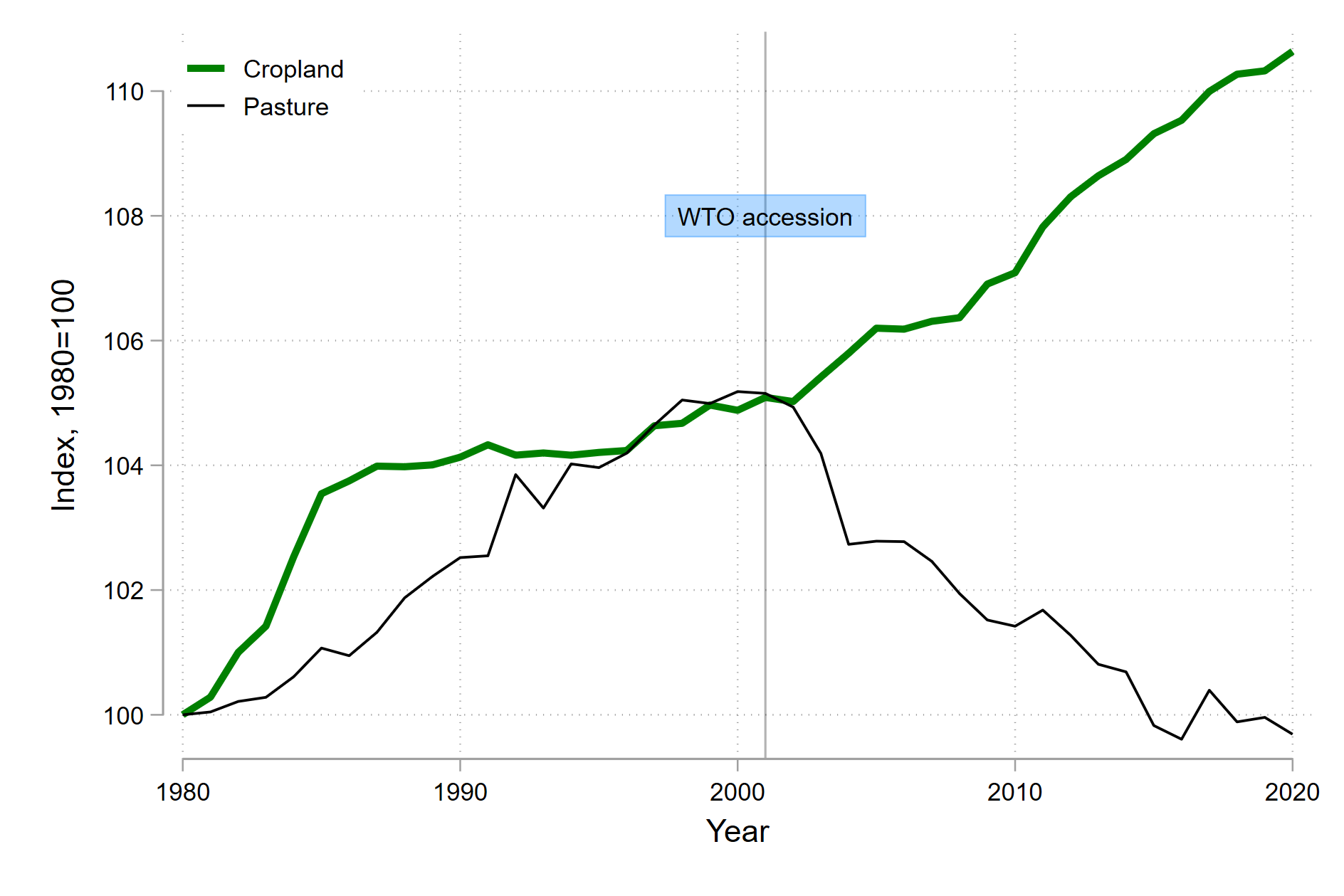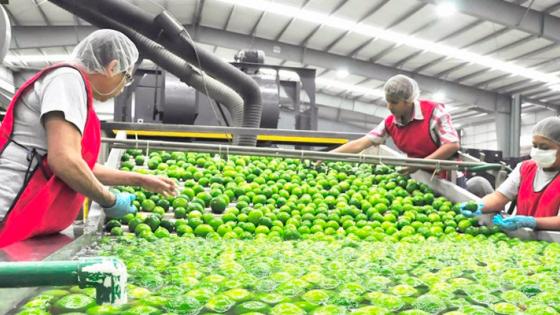China’s emergence as the world’s leading manufacturer has created headlines for decades. Scores of research papers, policy papers, and newspapers have documented what shiploads of cheap Chinese goods meant for manufacturers, workers, and consumers elsewhere (see Assche and Ma 2011, Acemoglu et al. 2014, Hombert and Matray 2015, Marin 2017, Feenstra et al. 2018, and Rodríguez-Clare et al. 2022). To feed its manufacturing industry, and economic development more broadly, China became the world’s largest importer of fossil fuels and minerals. The black curves in Figure 1 clearly illustrates the relentless rise of Chinese manufacturing in terms of both exports of final goods and imports of inputs. Also visible in the figure is another, less publicised shock to the global economy: after joining the WTO in 2001, China quickly went from being a net exporter of agricultural products to being the world’s largest importer. China currently imports more than 10% of all internationally traded agricultural goods, and more than 5% of global agricultural production.
Figure 1 China's trade in agricultural and non-agricultural goods
Note: Agricultural import is the dollar value of Chinese imports of agricultural goods relative to the total value of internationally traded agricultural good (green curve). The other variables are similarly defined. The vertical line indicates China's accession to the WTO in 2001.
That China as a consumer of agricultural products has drawn far less attention than China as a manufacturer would strike an observer from the 1990s as odd. With its large population and its increasing taste for meat, it was a legitimate concern whether global agriculture could satisfy increasing Chinese demand. “Who will feed China?”, asked Lester Brown in an influential article of the same title (Brown 1994). In the article, later expanded into a bestselling book with the subtitle “Wake-up Call for a Small Planet”, he predicted that with just 0.08 acres of grain land per capita, and little room for further expansion, China would soon have to import large quantities of food (Brown 1995). Farmers around the world would struggle to expand supply to meet Chinese demand, Brown warned, and the resulting steep increase in global food prices would be disastrous for the world’s poor.
With the benefit of 30 years of hindsight, we revisit Brown’s question in a recent paper (Hansen and Wingender 2023a). How did the world manage to supply China without apparent disastrous consequences for the world’s poor? And what about the broader question of how global agriculture adjusts to large demand shocks? The empirical literature contains few answers, which may seem surprising until one realises how hard it is to disentangle cause and effect. Trends in global demand are usually gradual and intertwined with demography, technical change, and other factors simultaneously affecting supply, not to mention that supply growth by itself may lead to higher demand. But in this particular case, quirks of Chinese trade policies allow us to discern the causal effects of a large demand shock to global agriculture.
Self-sufficiency and surging imports
China started to ease restrictions on imports of soybeans and a few other crops in 1995. Although a more substantial liberalisation of agricultural imports followed China’s accession to the WTO in 2001, China still kept a policy of self-sufficiency in important food crops, notably maize, rice, and wheat. The policy was introduced in the 1960s shortly after the famine caused by the Great Leap Forward, when food security became a pillar of legitimacy for the Communist Party (Zhan 2022). The Party reconfirmed the policy in response to the publication of Brown’s book to assure global leaders that China could indeed feed itself. To this day, China imports almost nothing of the crops covered by the self-sufficiency policy, but large quantities of other agricultural products. Countries and regions specialised in the crops covered by the policy were consequently far less exposed to rising Chinese demand than other places. We use this variation in exposure to Chinese demand to trace its effects from the global level to the country level and down to the local level in Brazil and the US, China’s biggest agricultural suppliers.
Chinese demand and global land use
Across all levels of aggregation, we find that farmers met Chinese demand by expanding cropland rather than by increasing yields. The response was so large that it is visible with the naked eye in global data. The green curve in Figure 2 shows that the extent of global cropland, which had been stagnating for a decade, began to increase after China liberalised imports of certain crops in 1995. The pace increased after China joined the WTO in 2001, leaving the extent of global cropland 7% larger in 2020 than in 1995. Our statistical analysis indicates that Chinese demand caused this entire increase.
Figure 2 Global land use
Notes: The green curve is global cropland. The black curve is global pastureland. We index both variables to 1980=100. The vertical line indicates China's accession to the WTO in 2001. China began liberalising import of soybeans and few other crops already in 1995.
That farmers expanded crop cultivation to meet Chinese demand benefited consumers, who did not experience soaring food prices, as Lester Brown predicted they would. Farmers benefitted, too, at least in the US, where detailed agricultural census data allow us to show that profit margins rose in areas exposed to Chinese demand.
The low food prices and the high profits came at an environmental cost. Much of the expansion of cropland came from cultivating land formerly used as pasture, as also suggested by the black curve in Figure 2. While conversion of pasture did result in a loss of biodiversity, an even greater loss of biodiversity came from expanding production into areas previously untouched by agriculture. We find that Chinese demand for agricultural products was the likely cause for between one third and two thirds of global deforestation since 1995.
Lessons and perspectives
As its population declines and economy slows, China’s demand for agricultural products will grow at slower pace in the future, but global demand will keep rising fast thanks to other big countries in Asia and Africa (Fukase and Martin 2016, 2020). Will the world be able to feed these countries, too? Our results suggest that it might. Pasture still constitutes more than half of global agricultural land, so further conversion of pasture into cropland could meet much of the shortfall. Such intensification reduces biodiversity, however, and our results suggest that global forests will continue to be under pressure as well.
The trade-off between food security and environmental degradation in a world with a rising demand for calories and animal protein can only be eased by increasing crop yields. High-yielding crop varieties associated with the Green Revolution and genetically modified crops have, for instance, substantially increased agricultural production without any expansion of cropland, on balance leading to better outcomes for both the environment and the poor (Gollin et al. 2021, Hansen and Wingender 2023b). Further investments in such innovations should have a high priority for both humanitarians and environmentalists.
References
Acemoglu, D, D Autor, D Dorn, G Hanson and B Price (2014), “The rise of China and the future of US manufacturing”, VoxEU.org, 28 September.
Assche, A V and A Ma (2011), “Geography and offshoring to China”, VoxEU.org, 18 May.
Brown, L R (1994), “Who will feed China,” World Watch 7(5): 10–19.
Brown, L R (1995), Who will feed China? Wake-up call for a small planet, WW Norton & Company.
Feenstra, R, H Ma, A Sasahara and Y Xu (2018), “Reconsidering the ‘China shock’ in trade”, VoxEU.org, 18 January.
Fukase, E and W Martin (2016), “Who will feed China in the 21st century? Income growth and food demand and supply in China,” Journal of Agricultural Economics 67(1): 3–23.
Fukase, E and W Martin (2020), “Economic growth, convergence, and world food demand and supply,” World Development 132: 104954.
Gollin, D, C W Hansen and A M Wingender (2021), "When agriculture drives development: Lessons from the Green Revolution", VoxEU.org, 20 March.
Hansen, C W and A M Wingender (2023a), “Who fed China?”, CEPR Discussion Paper 18540.
Hansen, C W and A M Wingender (2023b), "National and Global Impacts of Genetically Modified Crops", American Economic Review: Insights 5(2): 224-240.
Hombert, J and A Matray (2015), “US manufacturing firms, R&D and resilience to import competition from China”, VoxEU.org, 11 July.
Marin, D (2017), “The China Shock: Why Germany is different”, VoxEU.org, 7 September.
Rodríguez-Clare, A, M Ulate and J P Vasquez Andres (2022), “Trade with nominal rigidities: Understanding the unemployment and welfare effects of the China shock”, VoxEU.org, 17 May.
Zhan, S (2022), “The political economy of food import and self-reliance in China: 1949-2019,” Global Food History 8 (3): 194–212.





